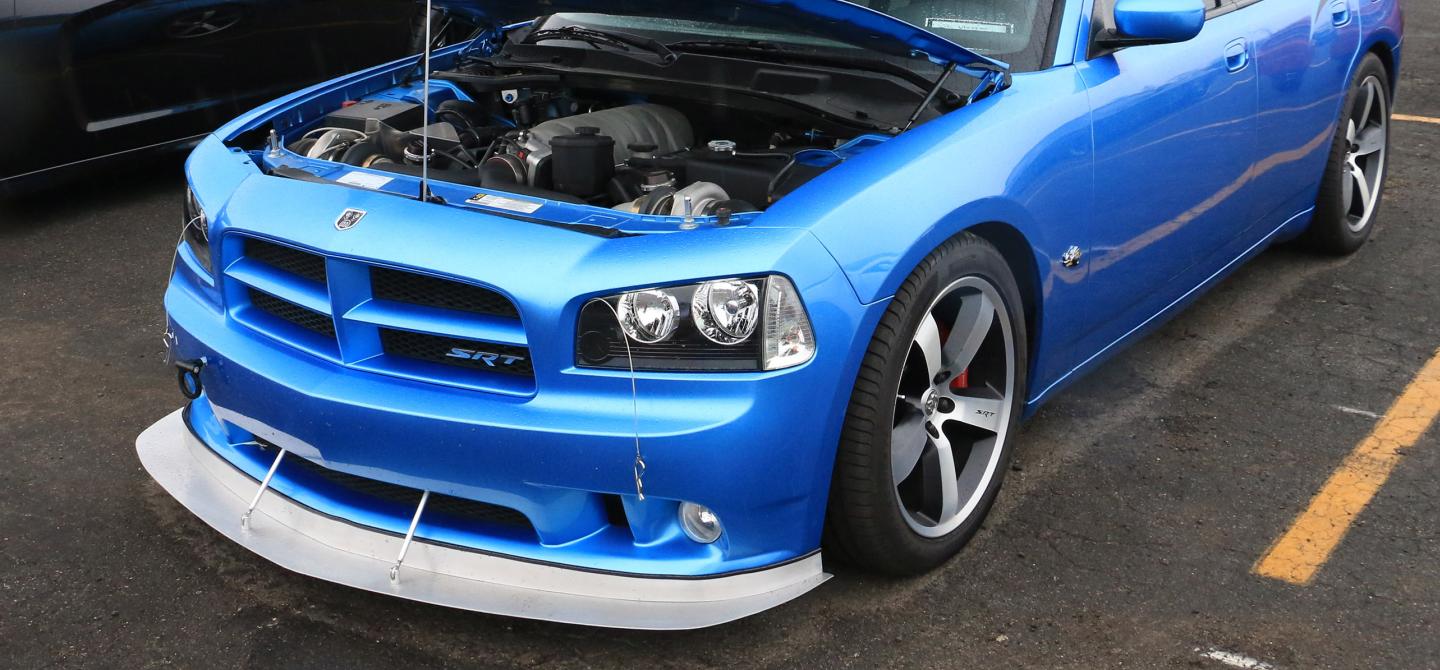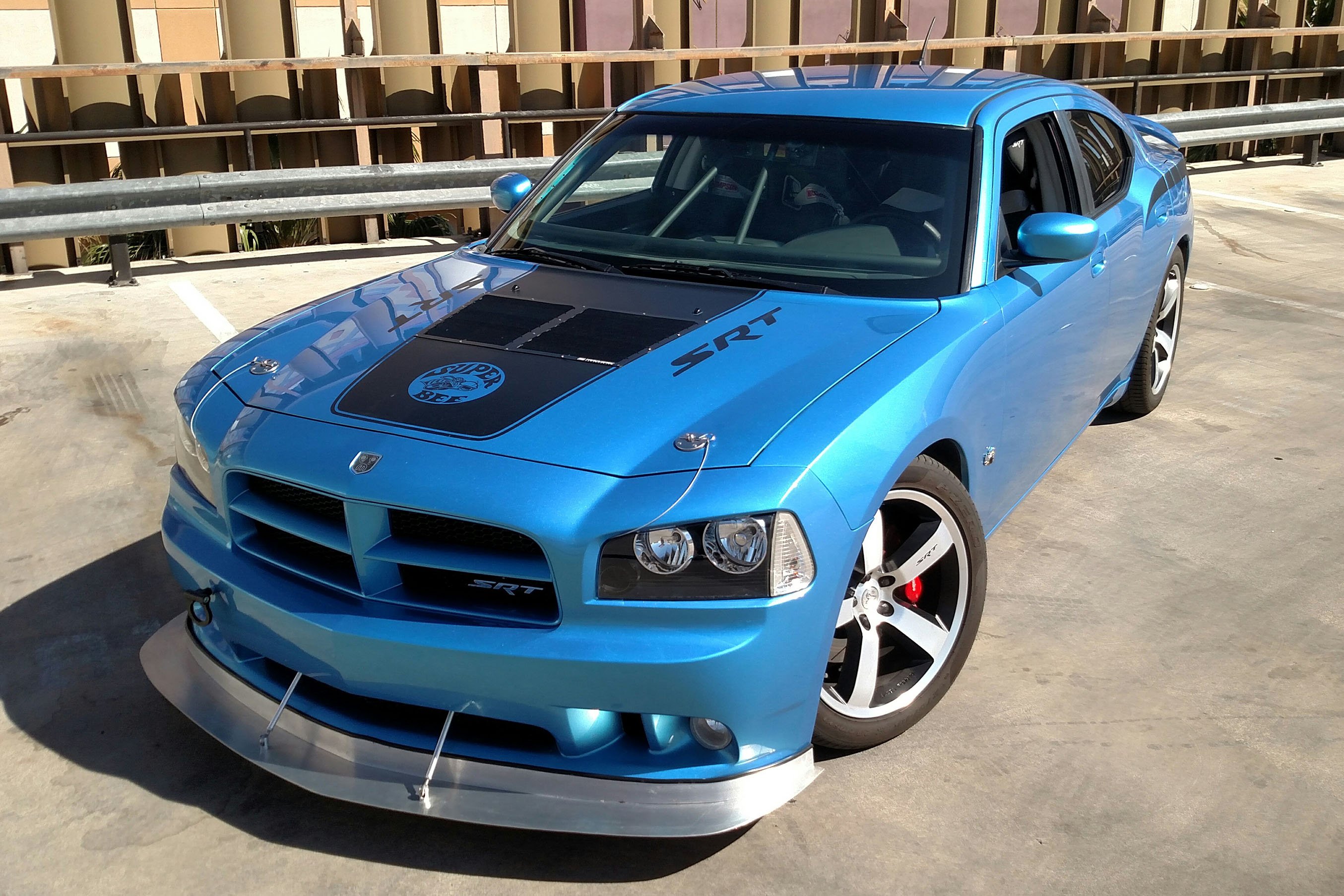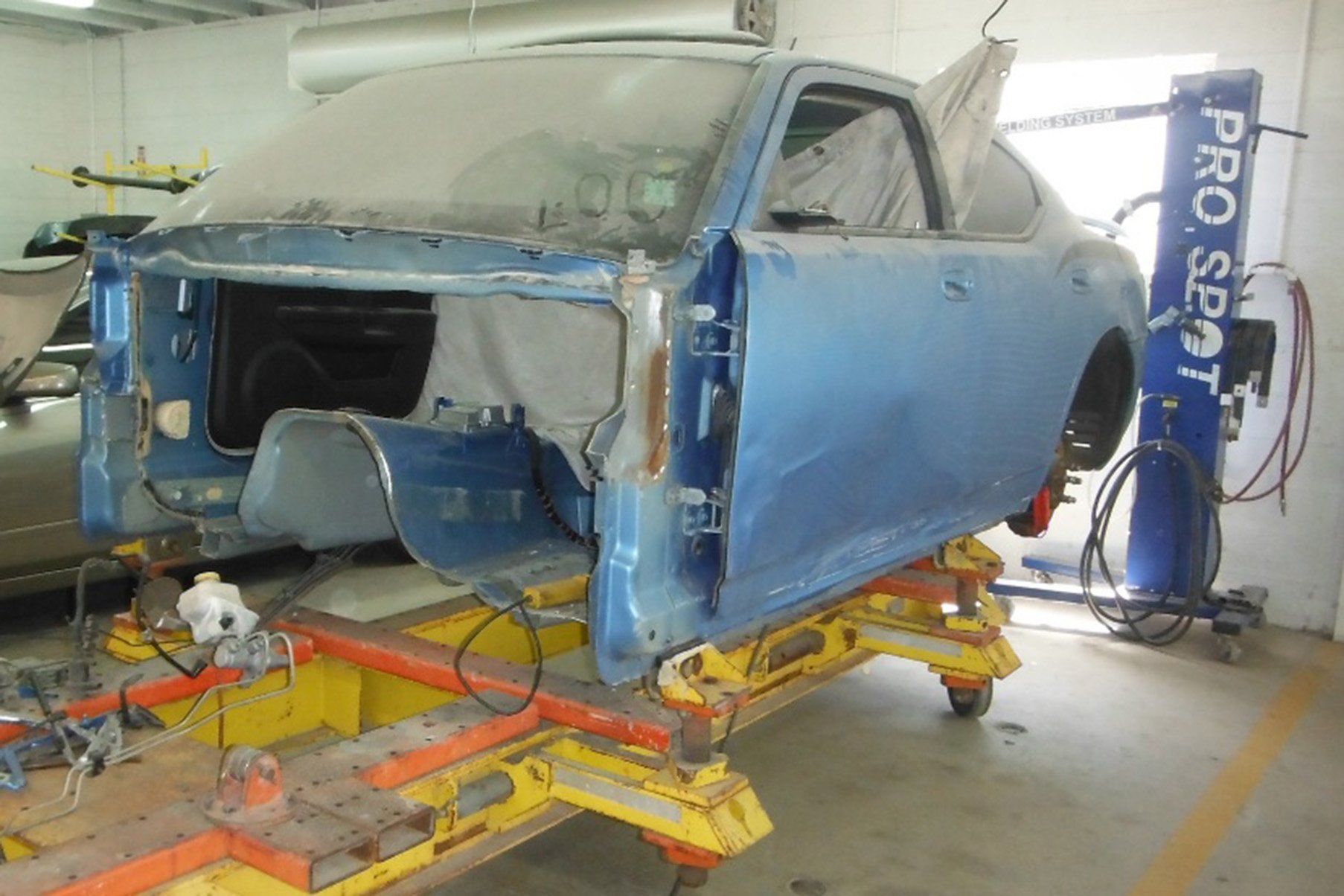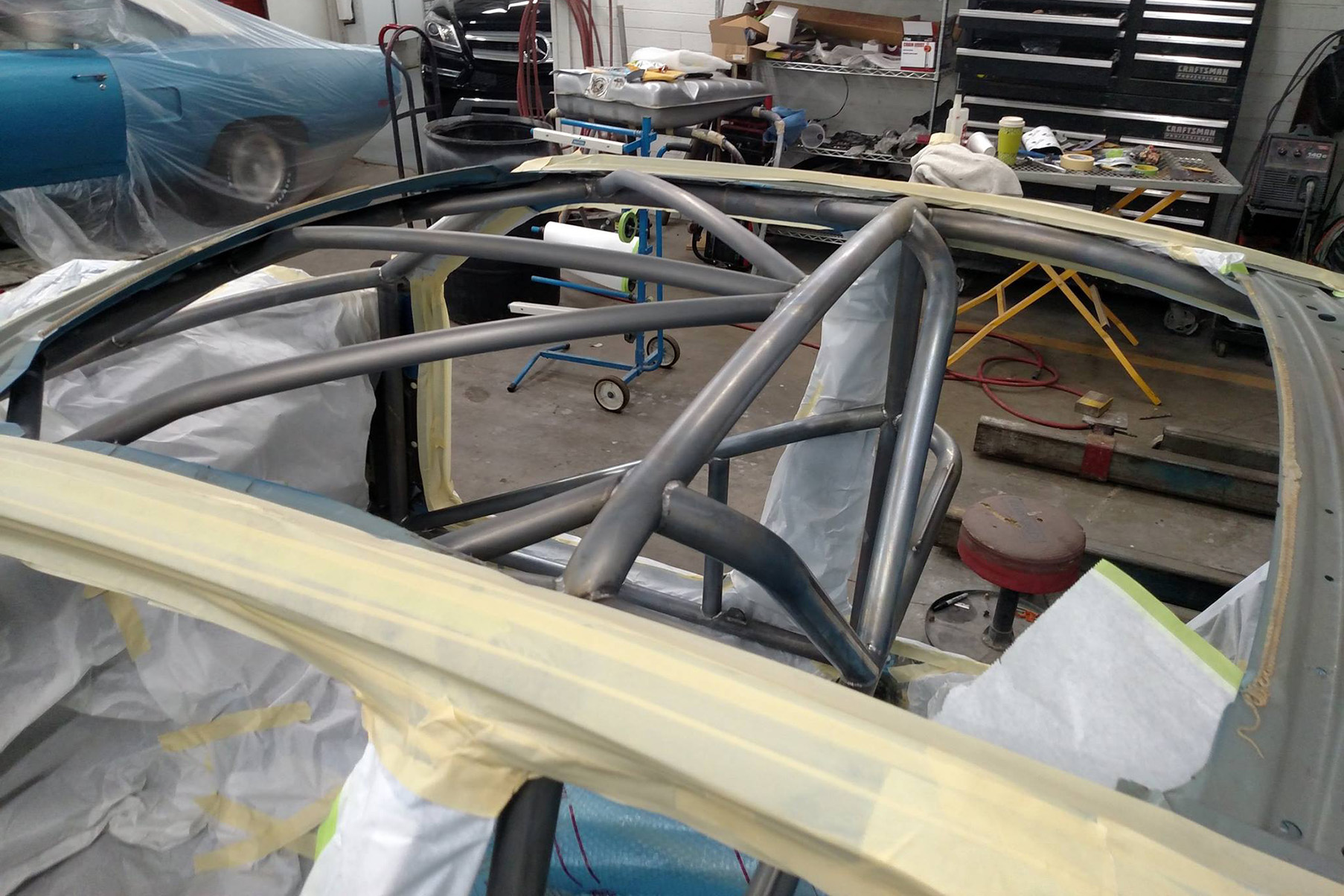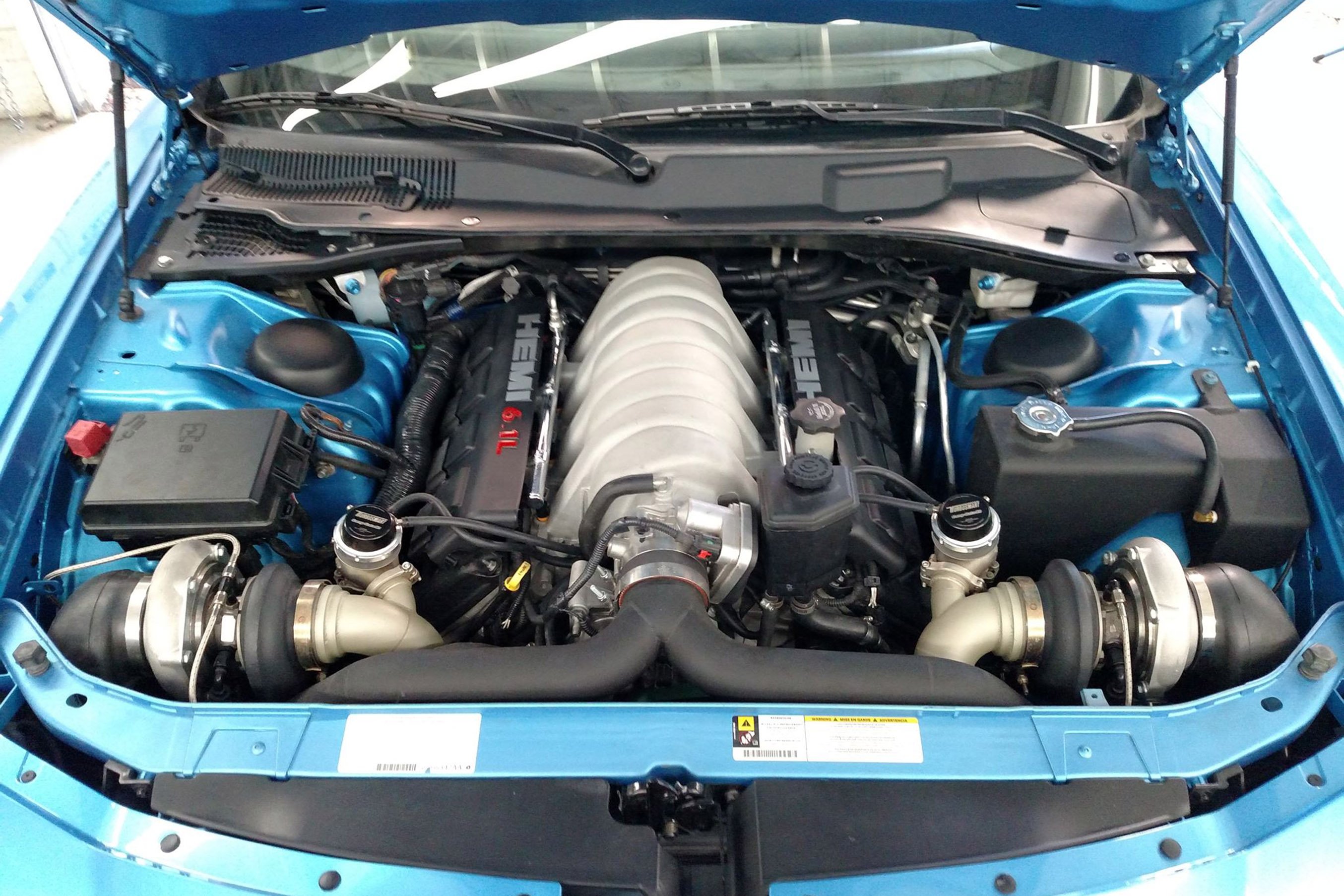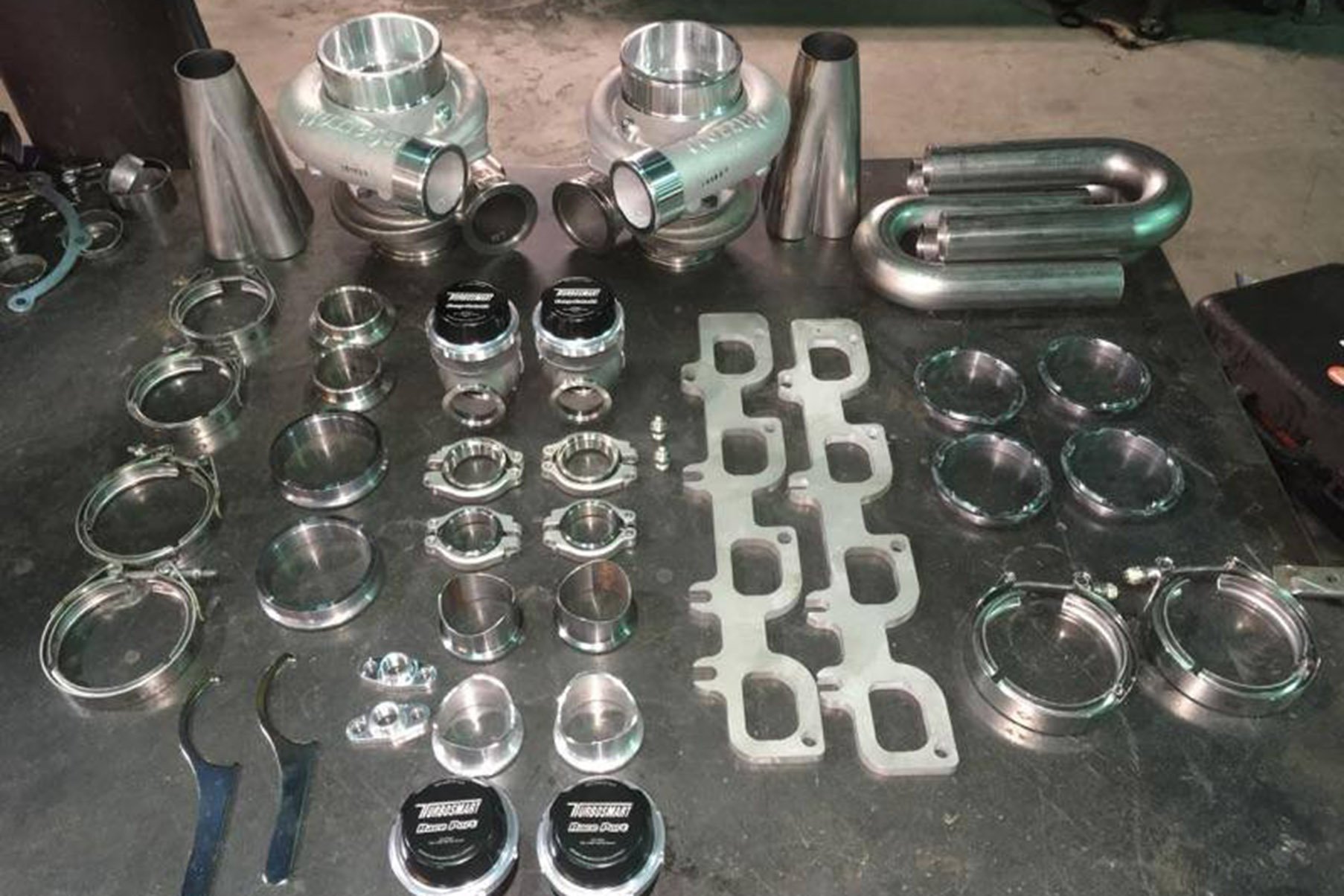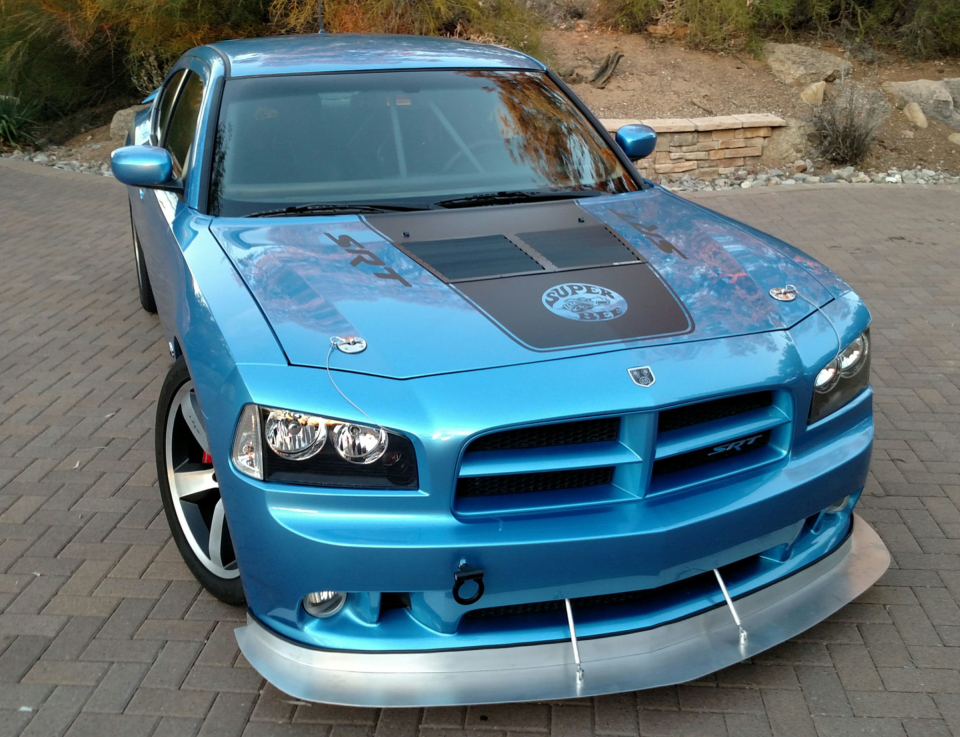There were two vehicles amongst the sea of wicked late-model Mopars on display at this year’s Spring Fest event held in Pomona, California that really made me stop to soak in the details. I’m generally a function-over-form kind of guy and being an LX owner myself, I have some understanding of the hurdles involved when it comes to tuning, modifying, and prepping these cars for use in racing and other hardcore performance applications. Matt Leischer’s blown Chrysler 300 SRT was one of those cars, for obvious reasons, and the other was this B5 Blue Charger Super Bee owned by Michael Laiserin of Scottsdale, Arizona.
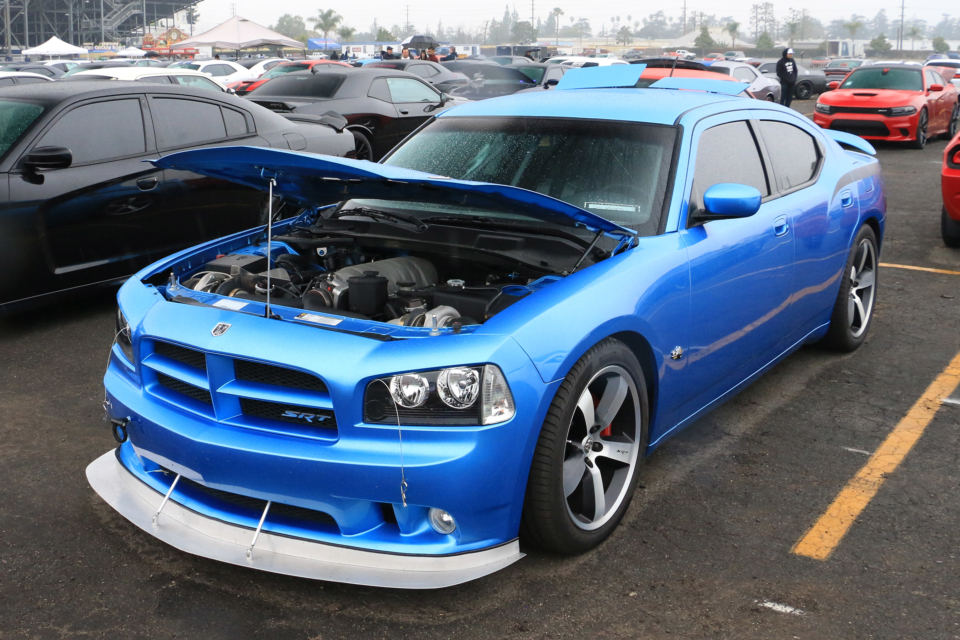
Seen here at the 2018 Spring Fest, Laiserin’s Charger isn’t as extroverted as some of the other builds that were on display at the show, but the tow hook and custom front splitter provide hints that there might be more going on here than you’d expect.
You could forgive car show attendees for dismissing the car as a tuned Charger at a glance, but something about the execution of the fabricated front splitter indicated to me that there was more going on here than just a few run-of-the-mill bolt-ons. A peek under the hood confirmed my suspicions – a twin turbo setup the likes of which I hadn’t seen before on a modern Hemi car. That alone I felt was worth digging deeper – why go turbo when supercharging is a much easier path with late-model Mopars, one which is far better supported by the aftermarket?
Turns out the turbo setup was just the tip of the iceberg.
“This car was built for the Silver State Challenge race,” explains Laiserin. As the owner of Michael’s Collision in Phoenix, Laiserin has a depth of knowledge about the underpinnings of the LX platform that’s rivaled by very few. In fact, it turns out that Mike’s shop was the one that helped up Leischer’s 300 back on the road last year. “It all kind of centers around that road race. It’s a car guy thing – you look at some ratted out shell of nothing and think – hey I can build that.”
It’s not often you’ll hear folks refer to a 2008 Dodge Charger SRT8 Super Bee as a “ratted out shell,” but to look at the state of condition the car was in when Laiserin got a hold of it, it’s actually a reasonable description. “You envision it done – and it only needs… everything!” Laiserin jokes. “I could have done this to a Charger police car, but I wanted a Super Bee. They were a limited edition model – they only made a thousand of them – and I specifically looked for a wrecked one because I knew we could get the car at a reasonable price and bring it back to life.”
The Super Bee isn’t Laiserin’s first Mopar. Years ago, Laiserin set up a 383ci powered 1970 Charger for autocross, much to the amusement of late-model and import guys at those events – until he cleaned house with it. “Nobody was doing anything like that with B-bodies at the time,” he notes. “It was fun as hell.”
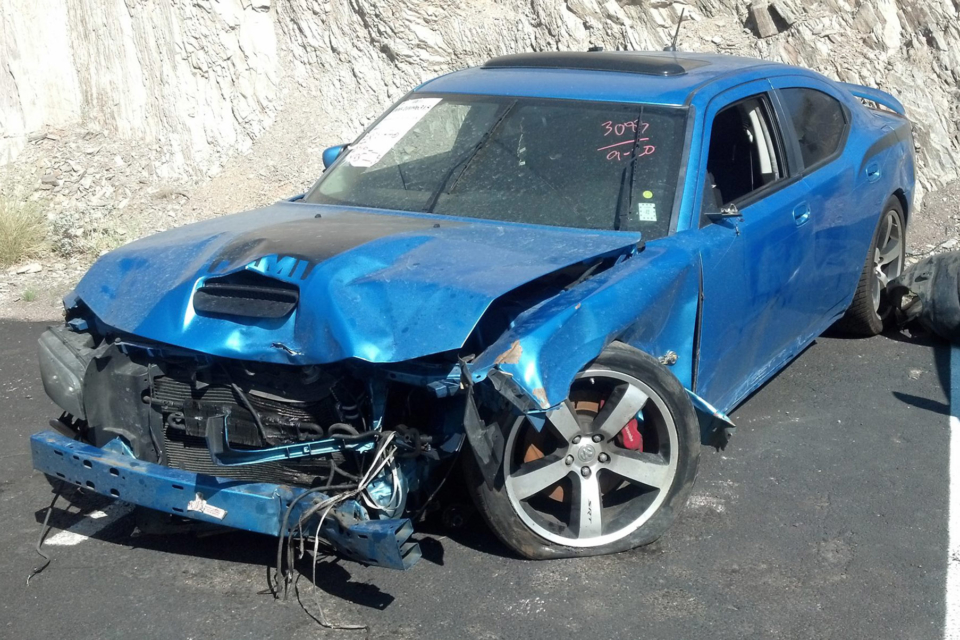
This is how the Super Bee looked when Laiserin took possession of it. While he’d always planned to build a street-legal race car out of it, the performance strategy changed as the project progressed.
That set Laiserin on the path of Mopar muscle car road racing that has culminated with this Super Bee, a car which is ostensibly a road-legal race car that still retains it’s share of its factory creature comforts. But don’t confuse this with some high-performance show car that sees the occasional track day or half-mile drag event – this car was built for endurance racing at sustained triple-digit speeds.
Nevada’s Targa Road Rally
While the Silver State Challenge has classes for varying experience and vehicle performance levels, the upper end of the spectrum will see in excess of 200 mph on some sections of the course. Formerly a 90-mile, one-way race, this year’s event brings some changes to the format. Although the course itself has been shortened down to 60 miles, competitors will now also race back to the original starting point, bringing the total distance driven up to 120 miles.
“I first read about it back in college in the late 80s,” Laiserin explains. “At that point it was one way, so they closed down 90-miles of highway 318 in Nevada to run the event, and you go as fast as you can down those roads. Back then when I read about that I thought I’d do that with the ’70 Charger someday – put a Hemi in there, some Daytona aero, and go 200 mph. Fast forward to 2014, and I thought, ‘What am I waiting for?’ So I get some information about the event and discover it’s more structured now. First-timers are in the Touring ‘rookie’ class, which is limited to a 110 mph average over the course of 90-miles and a top speed of 124 mph, no matter who you are and what vehicle you have.”
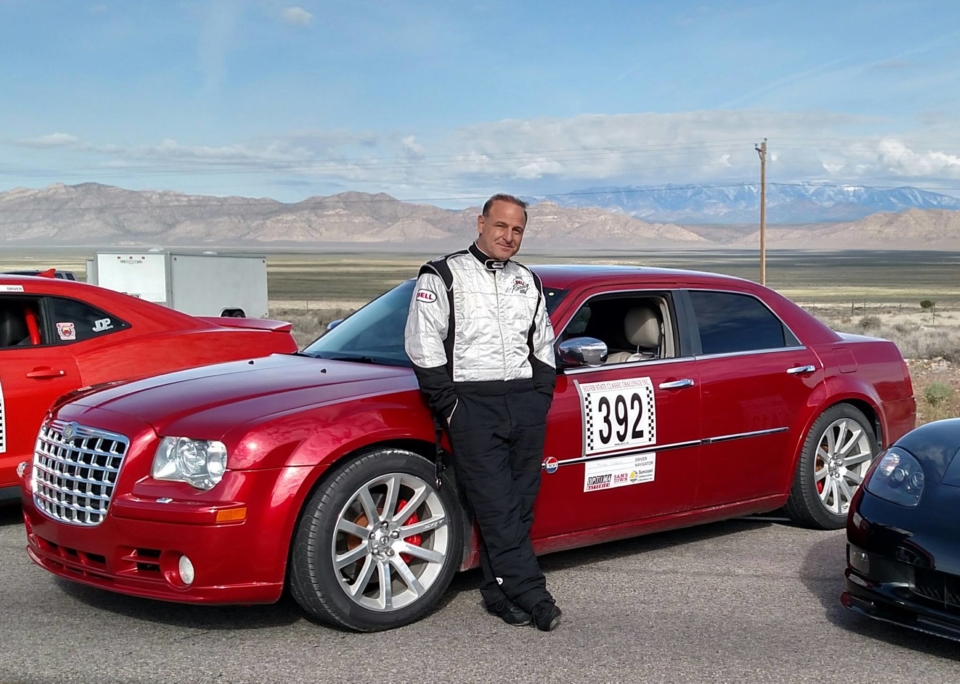
After doing well in his rookie Silver State Challenge event and taking the top podium spot his second time out, Laiserin knew he was on to something. Although his 2006 Chrysler 300C had served him well thus far, he knew that he would need to move up to a significantly more potent machine if he wanted to compete in the faster classes.
Laiserin decided to enter his daily driver in the race – a mostly-stock 5.7-liter Chrysler 300C. “Guys will fly out there and do their rookie run in a rental car,” he says. “You’re doing most of the race at around 120 mph because once you get into the canyons where it’s curvy, the pace is much slower.”
Despite both rain and hail during the race, Laiserin placed in the top ten in his class. “It was an absolute blast,” he says. “So I went back the following spring in the same car, only this time I was in the Grand Touring class. Here the average target speed is 125 mph, and the limited top speed is 140. For that you need a five-point racing harness in the car, so we had to fabricate a harness bar for the 300. I actually came in first place in the Grand Touring class at the race in the spring of 2015.”
Laiserin was understandably hooked, but he also knew he was going to need more firepower if he wanted to come back and run toe-to-toe with the rest of the field in the event’s faster classes.
Built To Run
“I bought this wrecked Super Bee at auction, and the original plan was just to use that as the race car,” he says. “I figured I could get the car, repair it, throw a Kenne Bell blower on it and a roll bar and be done for maybe 20-25 grand. That was the plan went I bought the car.”
But like many projects – especially those that involve motorsport – the original plan quickly went out the window.
“I replaced everything on that car from the firewall forward,” he says. “That wasn’t the challenge – it was the cage, the engine, the turbo setup – all that stuff requires more time and money than you expect. The race in a few weeks will be the first time I’ve been back to the Silver State Challenge in three years.”
I bought this wrecked Super Bee at auction, and the original plan was just to use that as the race car. I figured I could get the car, repair it, throw a Kenne Bell blower on it and a roll bar and be done for maybe 20, 25 grand.
Laiserin says the car was in rougher shape than the internet auction photos indicated. "It had been walloped pretty good," he recalls. "It had been hit hard enough to break the steering wheel off of the steering column. But we have the equipment, and I'd fixed other LX cars before this one, so I knew what it was going to take to make it right again."
The car currently rides on a set of KW Variant 2 coilovers while Hotchkis sway bars at the front and rear keep the body roll in check. Stopping power is provided by the factory Brembo setup with Hawk brake pads, while both grip and top speed capability have been enhanced by swapping from the OEM 245mm-width Goodyear F1 tire to the Hellcat-spec 275mm Pirelli P Zero, the latter of which is rated for the Hellcat’s 200+ mph top speed.
Inside, the Charger’s original seats have been replaced by a pair of Sparco race buckets that can accommodate the five-point Simpson harnesses, while an 8-point roll cage with intrusion bars for doors, windshield, and roof have been added for occupant safety and to comply with the event’s regulations for the Grand Sport class Laiserin will be competing in.
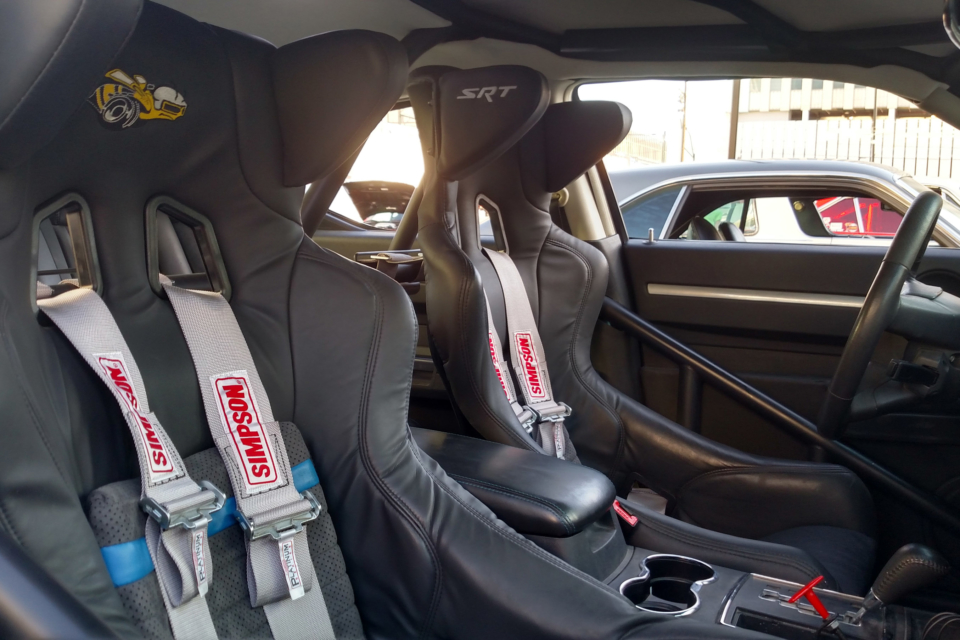
While some might think an 8-point cage is overkill for a car that still maintains many of its original creature comforts, it is undoubtedly money well spent. While you might not need this level of structural safety on a drag strip, it’s vital considering the kind of trouble you can get into if things go wrong at speeds more than 180 mph on a course where trees are familiar sights on the side of the road.
Under the hood, the Super Bee sports a twin-turbo setup rather than the Kenne Bell supercharger that Laiserin had initially planned to do. “I figured I’d stick a twin-screw on it and go racing,” he says. “A longtime friend of mine who used to run Forced Induction Tuning in Phoenix convinced me otherwise though. ‘It’ll make the power, and it’s got the old-school look that you like, but you’re not drag racing it,’ he told me. ‘You’re going to be running high speed for forty minutes at a time, and the supercharger is going to heat soak way too much. Consider turbos.’ So I finally decided to budget a little more and go that route instead.”
Laiserin says that his Charger often flies under the radar of show-goers, no doubt in part because the turbo setup is so sanitary that it looks like it could be a factory install.
Laiserin also decided that rather than hiding the turbochargers near the exhaust manifolds – their usual location on LX cars – he wanted them up top. “I wanted to be able to look at them and admire them,” he explains. “The engine builder told me that no one has done that because there’s no room, so we relocated the ABS unit and the washer reservoir. They’re both still in the car.”
The forced induction setup consists of a pair of reverse-rotation 66mm Garrett generation II GTX turbochargers along with twin custom intercoolers, which sits atop the 6.1-liter Hemi that’s been stroked to 415 cubic inches. Callies hardware fortifies the bottom end of the 6.8-liter Hemi, while a custom-ground camshaft was spec’d to take full advantage of the turbos. Running on 7 pounds of boost, Laiserin saw 699 rear-wheel horsepower on the dyno and says there’s a lot more left in it.
The Road Ahead
Laiserin tells me that while the upcoming race will likely set the path for some of the future changes to the car, he’s already got some ideas in mind.
“It just doesn’t end,” he quips. “The next step has got to be a fuel cell and fuel system upgrades so I can turn up the boost; otherwise I’m running 300 horsepower short of what its potential is.”
Unsurprisingly, the added power is putting a strain on the rest of the drivetrain. “I’m also going to need a driveshaft soon,” he says. “The problem is finding a drive shaft that’s designed around this kind of road racing rather than drag racing. There are sections of the course where you can be close to 200 mph for several minutes at a time, so we’ve been talking to some manufacturers about building a custom carbon fiber or two-piece aluminum driveshaft.”
But despite all the hard work, research, and expense, Laiserin says the point of it all is just to have some fun. “It was never really about getting trophies and setting records,” he tells me. “It was about figuring out how fast I could drive on a public highway with the air conditioning on.”


